Voices.com saw a 25% increase in year-over-year revenue after publishing its case study.
If you want to replicate its revenue growth in your company, you’re in the right place.
This guide outlines how to write a case study in seven high-level steps, along with three very different real-world case study examples.
How to Write a Case Study in 7 High-Level Steps
A powerful story convinces prospective customers that you’re the real deal. This section outlines the seven core steps of writing an effective case study that attracts your ideal customers on autopilot.
Step 1. Gather marketers and sales in the same room
Too often, we hear stories of marketing and sales playing the blame game—and it’s a shame as alignment between these two opposing departments breaks down silos and unlocks revenue acceleration in the long run.

Consider the following statistics from LinkedIn:
- 60% of members believed that marketing-and-sales misalignment could damage financial performance
- LinkedIn members exposed to a company’s marketing messages on the platform are 25% more likely to respond to a message from said company’s salesperson
- Sales folks who often share quality content are 45% more likely to exceed their sales quota
CEOs (or other C-suite roles like CROs) should gather marketing and sales in a room and get them on the same page. Rather than creating a marketing case study on the fly, let the sales team lead you.
Use the following questions to narrow down on the type of content you should create:
1. “What was the most common reason prospective clients bought our product?” 2. “What was the most common objection you had to overcome before potential clients bought our product?” 3. “What was the top product feature that prospective customers are attracted to when buying?” 4. “What are the best sales deals you’ve closed in the last year?” 5. “Which clients were the easiest to close?”
Questions #1-#3 shape the elements of your customer success story, such as the product features, angle, and headline.
Whereas, questions #4 and #5 identify your most profitable clients (a.k.a. your case study candidate) and the common attributes to focus on to attract more of them.
Your sales team’s response provides one side of the story. To gain a better understanding of your best customers today, use a tool like Breadcrumbs Reveal.
It analyzes your marketing, sales, and product data and tells you what attributes and actions are the best predictors of revenue. To get started:
- Connect your data sources with Reveal
- Define your criteria for success (e.g., enterprise plan)
- Run it!
Breadcrumbs Reveal will return a detailed view of your best customers today. It will also reveal your data health and the data that can be trusted.

Use the data provided to pin down the candidates for your client case studies—and update your ideal customer profile (ICP) while you’re at it.
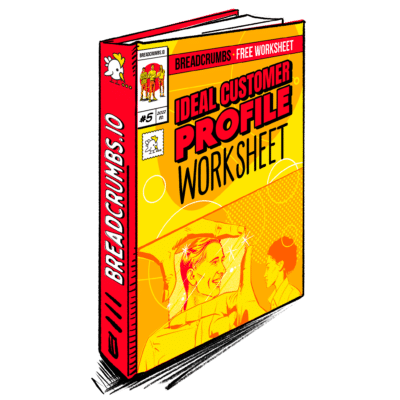
Ebook
Ideal Customer Profile (ICP) Worksheet
Learn how to create an Ideal Customer Profile and build a successful sales strategy with this Ideal Customer Profile (ICP) Worksheet.
Breadcrumbs Reveal is free for a limited time. Grab your free account to identify the attributes and actions that drive your revenue today.
Step 2. Pick the best candidate
Not all customers are equal. For example, a company that recently moved upmarket will focus on enterprise clients.
Now that you’ve identified your best customers today and the customer objections you need to overcome, it’s time to find the right candidate.
Ideally, the right candidate for your before-and-after story ticks these two boxes:
- Belongs in your best customer segments
- Achieves stellar results from your product or service
GrowSurf, a referral software company, focused on newsletter publishers.
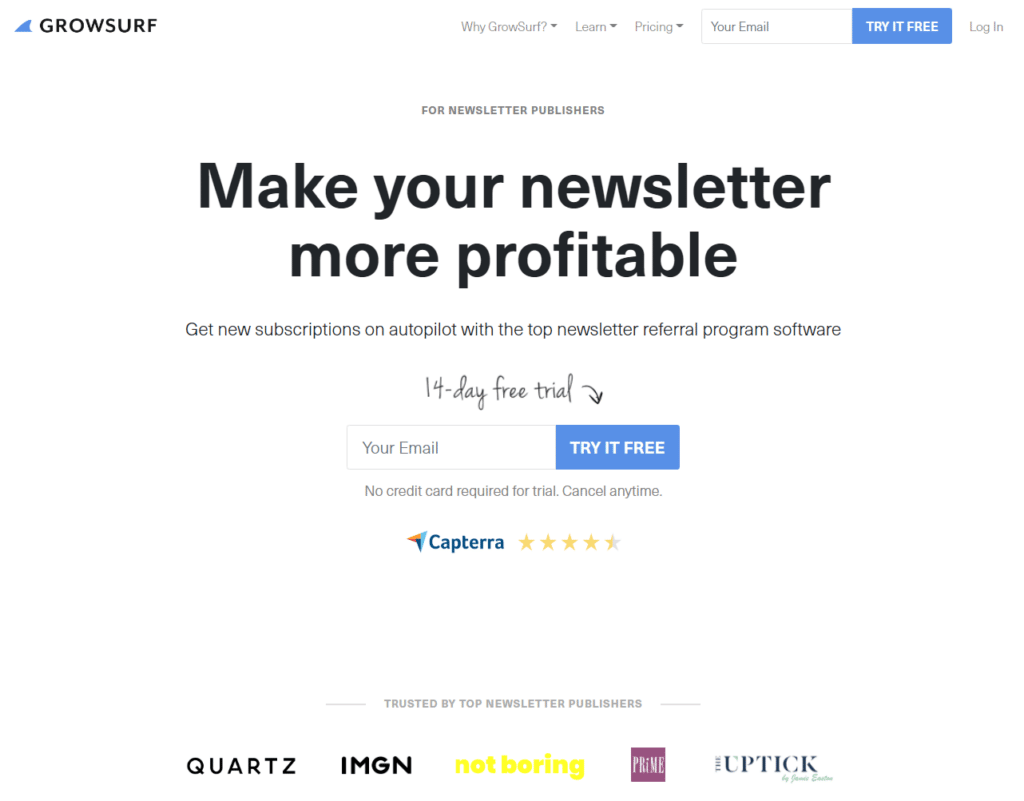
Co-founder Kevin Yun explains his choice with Breadcrumbs, “They were running a great referral program and getting great results. The top five referrers had around 500 referrals collectively.”
Step 3. Request a case study interview
Writing case studies involves more than a compelling story, persuasive writing style, and authentic, real-world images that show the collaboration in action.
For all this to happen, you need to convince the client for an interview at the right time.
There are two options, according to David Ciccarelli, CEO and founder of Voices.com. Either you ask after delivering the work or when you’re starting to see significant results.
He explains to Breadcrumbs, “Asking before you finish the work will get you a quick ‘no.’ However, when you wait until the client has experienced success, you’re far more likely to get a ‘yes.’”
This brings us to the next question: who should ask the client for an interview?
Our take: the salesperson, as they’ve already established rapport and have the closest contact with the client.
At Voices.com, the account manager invites the customer for an interview. If it’s a yes, the account manager makes a nomination.
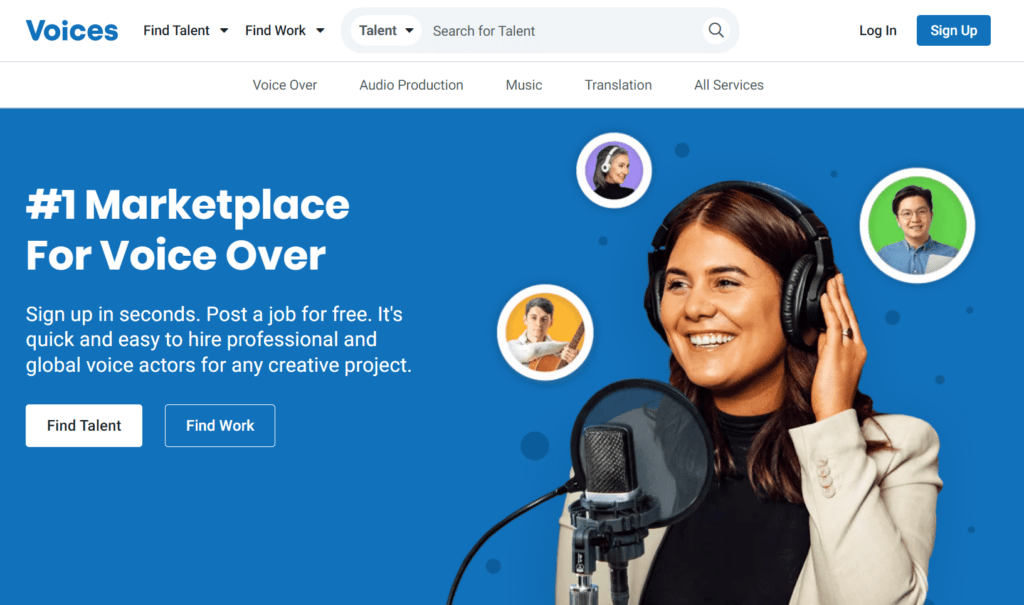
This process involves filling a form in the CRM, indicating the company name, point of contact, project details, and a link to the deliverables.
Next, these nominations are handed off to the communications manager, who acts as the case study’s creator and brand steward and determines if there’s a fit.
If there is, the Voices.com team proceeds with the case study interview.
Run a contest to gain momentum in your case study initiative. At Voices.com, the sales rep who submits the most number of nominations wins a prize.
Not only do you get the sought-after case study, but you also encourage the sales team to participate in a friendly game, boosting employee engagement by tenfold.
Step 4. Overcome concerns and objections
Sales reps who overcome objections enjoy a close rate as high as 64%—all the more reason you shouldn’t let the initial objections stop you from closing.
Yes, this applies to case studies.
There are various ways to bypass these initial nos.
If the client is sensitive about sharing results, instead of explicitly listing the exact figures in the case study, opt for a percentage format (e.g., “115% increase of revenue” rather than “…revenue increased to $593,938”).
Other ways to overcome objections include:
(i) Anonymizing names, roles, or even the name of their companies
Instead of: “Annie Lee, Head of Marketing at Startup ABC” Go with: “Our client, the Head of Marketing at a B2C health startup”
(ii) Sharing process without diving into the strategy’s specifics
Describe the general approach to achieving results. Avoid the nitty-gritty that gives away your top strategies.
Instead of: “We used [SEO tool] keyword tracker, selected the criteria, and inputted formula, …” Go with: “Analyzed gaps in competitors and brainstormed new content”
It’s a mouthful, but you get the idea.
Sometimes, clients need more context before agreeing to a case study interview. Share how you plan to use and distribute it.
What you want to do here is sweeten the pot.
Talk about how the case study improves their SEO or boosts visibility to potential customers.
Voices.com always tells its clients how it plans to share the case study via social media posts and its newsletter. Since the latter channel has hundreds of thousands of subscribers, it’s “sufficient enough to demonstrate the quality of the case study,” says David.
“For many clients, the added brand visibility is a huge incentive.”
A word of caution, if the objection centers around legal restrictions or if the client just isn’t interested, move on to the next client.
“Rather than jeopardizing our business relationship, we work at improving their experience,” adds David.
Step 5. Interview the client and gather intel
It’s D-Day.
Prepare a list of open-ended questions that outlines the client’s before-and-after transformation.
“When you frame your questions,” shares Kevin Yun, co-founder of GrowSurf, “You can synthesize the story from the transcript and craft a case study that resonates with prospects.”
Here are eight questions to get you started:
1. “What was your team’s process before using [Product]?” 2. “What were the costs and the major pain points of this process?” 3. “Were you comparing alternative solutions? Which ones?” 4. “Describe a few of the reasons you decided to go with [Product].” 5. “What risks or reservations did you have before choosing?” 6. “How do you and your team currently use [Product]?” 7. “What types of goals or tasks are you using the platform to accomplish?” 8. “What is a feature or part of [Product] that you or your team use most frequently? Why?”
These answers are not only helpful in your case study, but also your customer research and content marketing strategy.
For example, #3 unearths insights about your competitors and shapes the backbone of your content strategy. This is also valuable if you’re wondering what to write for your product comparison posts.
Pro Tip: Keep the data at the back of your mind as you start planning for the case study content. While the customer quote adds the human element and the emotional ‘oomph’, it’s the data that proves your expertise.
“Consolidating all the data allows you to leverage key takeaways and highlights when building your first-ever business case study, “ shares Gabrielle Carreiro, founder of Binge Digital, with Breadcrumbs.
“This is important because not only do you want to back up your work with quantifiable results, but you also want to draw attention to the success you’ve driven and position yourself as a thought leader in your industry.”
Step 6. Create the case study and bring it to life
By now, you should have a lot of information at your fingertips. Review the interview transcript and edit the client’s answers into the following format:
- Overview: Introduce the client and the current state of the company, along with a compelling headline
- Problem: Describe the ‘trigger’ that led the client to look for your solution. Agitate the pain point and share what’s not working
- Solution: Explain what you did to solve the problem. This is the perfect chance to spotlight your process and value proposition (or better yet, your unique selling proposition)
- Results: Share the results you delivered in exact figures. If it’s not possible, anonymize the data
Design follows copy.
After writing the case study content, work with the design team to explore how you can bring the elements (e.g., case study headline, background colors) to life.
-
What Is B2B Retargeting and How Can It Generate More Leads?
Read more: What Is B2B Retargeting and How Can It Generate More Leads?Have you ever casually browsed a product online, only to suddenly see ads and promotions…
Step 7. Distribute the case study and repurpose in other formats
Your new case study is finally completed.
Now all that’s left to do is to promote it and show everyone what you have accomplished in your space.
Consider the following distribution ideas to boost visibility:
- Upload it on a digital asset management platform (DAM) where every stakeholder can easily access the case studies
- Promote it in all employees’ email signatures
- Share it on social media and encourage your team to do the same
- Cross-post on channels like LinkedIn and Medium. Don’t forget to link it back to the original source.
- Guest post on relevant publications and non-competing blogs to add a backlink to your case study
- Print your case study and distribute it to prospects at networking events and large conferences. This beats handing out business cards that are bound to go missing amid the chaos!
- Pitch your case study to podcasts. Tell the podcast host about your unique process and offer your unique take to their listeners.
- Repurpose or expand your case study into a webinar, infographic, checklist, blog post, or ebook
- Subscribe to sourcing services like Help a Reporter (HARO) and Help a B2B Writer. Pitch your case studies when you come across a relevant opportunity
Content distribution is never a one-off task. Promote your case studies and repurpose them as needed to attract new clients.
3 Very Different Case Study Examples (And Why They Work)
This section details a real-world case study analysis featuring some of our favorite startups. By the end of it, you’ll walk away with a few ideas to inspire your own.
1. GrowSurf
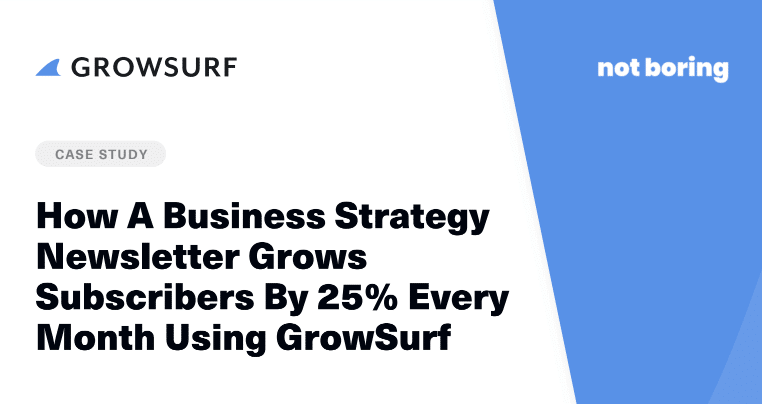
Headline: How A Business Strategy Newsletter Grows Subscribers By 25% Every Month Using GrowSurf
Results: 22% of lead sign-ups
Why it works:
GrowSurf’s case study starts with a bang.
The headline instantly speaks to the lead’s desire (i.e., grow subscribers every month).
It then lists common problems that leads relate to (using referral software to build a custom referral program without coding skills).
Next, we see GrowSurf diving into its specific features and how it effortlessly solved the client’s problem.
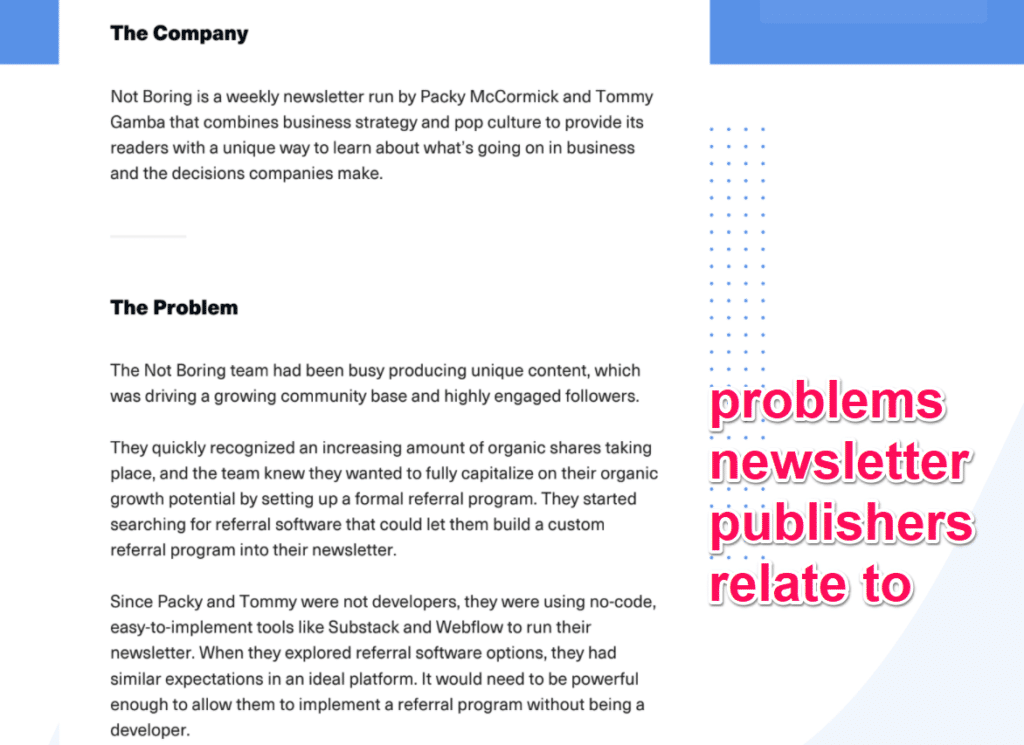
Note how GrowSurf showcases its automagic form detection tool and embedded elements while tying back to the client’s main problem (coding).
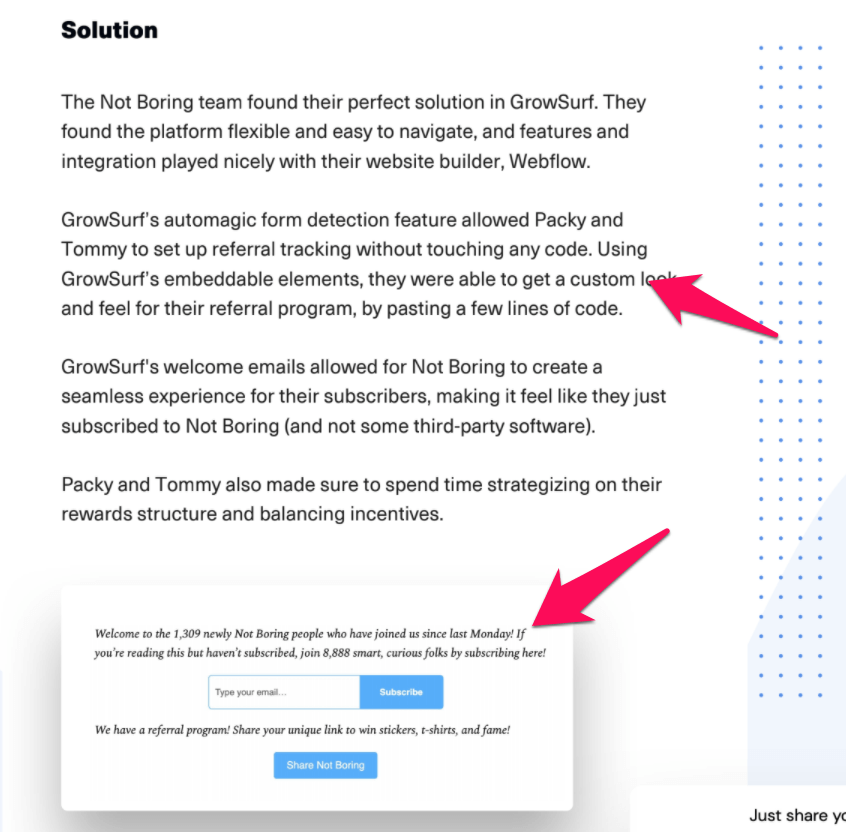
Notice how GrowSurf strategically places the screenshots?
These pictures in action show how the referral software works. They fill in the lead’s curiosity gap.
The case study ends with the results GrowSurf delivered, along with a great quote from its client.
See how the testimonial highlights the ease of use (no coding required) and the biggest benefit (lowering business costs and saving money).
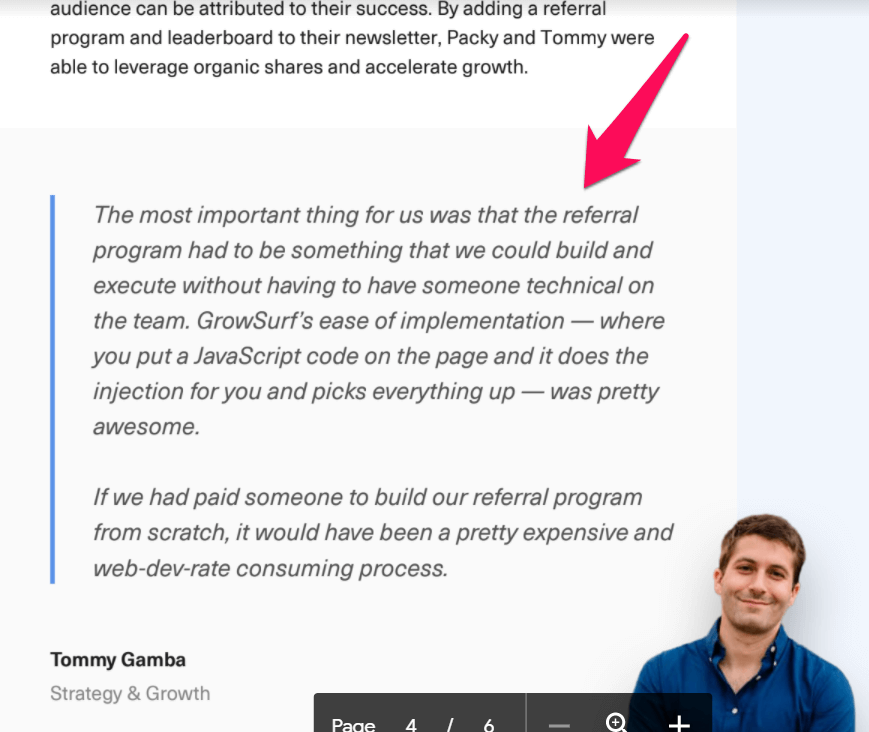
A client’s quote that shows your value proposition is way more irresistible than you making a statement.
GrowSurf finishes off its case study with a great call to action (CTA).

What GrowSurf teaches us about how to write a case study: Show, don’t tell. GrowSurf highlights its client’s quotes to demonstrate the effectiveness of its software.
2. Playvox
Headline: Zendesk for Playvox Testimonial
Why it works:
On-location video case studies pack a persuasive punch.
Playvox’s video testimonial highlights its unique selling proposition (USP), completely grabbing the prospect’s attention hook, line, and sinker (“…ability to be dynamic and adaptable.”).
It then segues to a screenshot of the product, showing it in action. This is crucial as it helps prospects envision what it’s like to use Playvox in their work.

The video then shows a series of video cuts, including the client’s headquarters and team members. It paints a professional impression, engaging prospective customers to continue watching the video.
Towards the end, the client shares the potential opportunity loss had they not discovered a solution like Playvox.
What Playvox teaches us about how to write a case study: It’s vital to highlight the client in the case study, but don’t forget to show your product in action—especially when they talk about how a specific feature solves a problem.
3. Voices.com
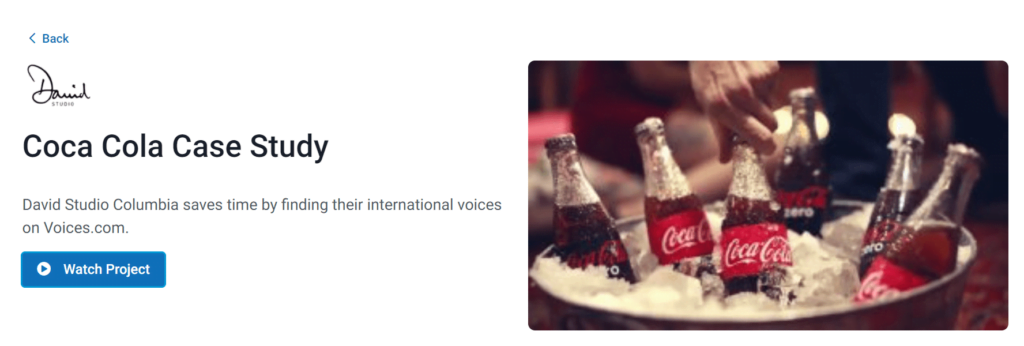
Headline: Coca Cola Case Study
Results: 25% increase of year-over-year revenue. This case study is read more than 2500 times every year. It also attracted new businesses and expanded Voice.com’s relationship with the client.
Why it works:
Did Voices.com just prove simple headlines can work?
In this case, it did.
And that’s because Coca-Cola’s a famous international brand that enjoys global appeal (note: Playvox also uses a similar strategy).
Tip: If your client’s a lesser-known company in its industry, the “[Name] Case Study” headline formula probably won’t work. That’s okay! Stick to benefits, like the way GrowSurf did.
It’s clear Voices.com knows its angle in this case study: Saving time and money.
As we scroll down, we see three key figures, which piques interest.

Right after giving us an overview of its client, Voices.com digs deep into the problem.
Note how these three paragraphs spotlight the wasted hours on locating and preparing the talent, frustrating delays, and disrupted operations.
Leads will nod their head in agreement as they read this section. This is a brilliant way to agitate major pain points.

Next up, the ‘meat’ of the case study.
Voices.com calls attention to its solution (e.g., pre-selecting and verifying the talent), along with the benefits and outcomes it delivered (i.e., work up to five projects a day, delegate 80% of administrative work).

There’s more.
Scroll down the case study, and we see video clips scattered within the post.
For leads that are still on the fence, these are visual proofs to address their objections to the quality of work.
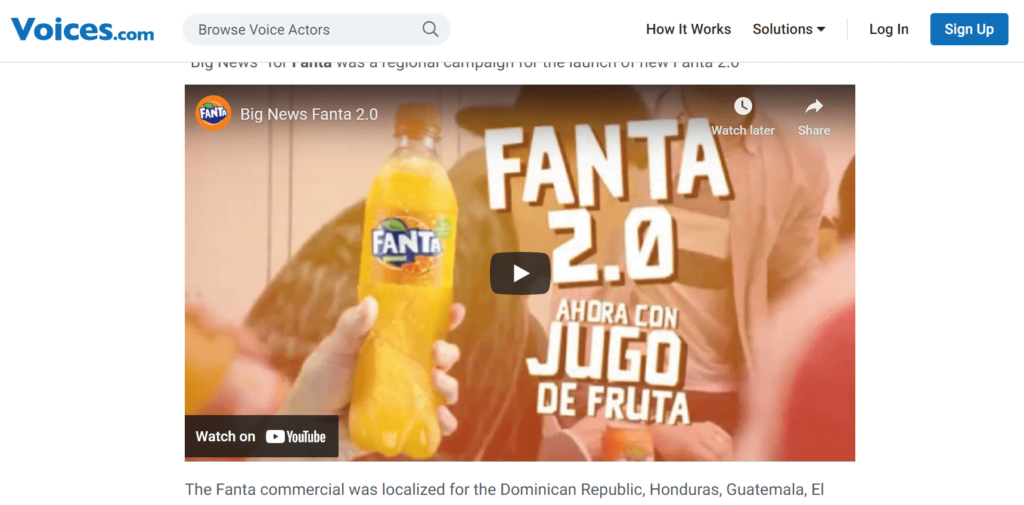
Voices.com ends off on an impressive note. Towards the end, we see it reinforcing the results it delivered.

What Voices.com teaches us about how to write a case study: Highlight your credibility with visual proof and a benefit-driven process.
Now That You’ve Learned How To Write A Case Study, What’s Next?
Case studies highlight your unique expertise and convince a skeptical lead. If you haven’t been dedicating time and resources to create them, you’re missing out on many revenue opportunities.
Generally, leads who read case studies sit further down the funnel and are ready for sales. If you want to pitch these leads (what salesperson doesn’t?), use a contact scoring tool like Breadcrumbs.
Here’s how it works:
- Connect your CRM with Breadcrumbs
- Determine your ideal customer’s attributes in the Fit model (e.g., CMO from a $10ARR company with 50 employees)
- Determine the actions that show a buying intent in the Activity model
For example, if you want to target prospects who read case studies on your site, select Page Visits under Matching Event and include the URL accordingly.

Each action and attribute is assigned a score. The more actions a lead completes and the more attributes they “fit,” the higher their score will be.
Once they hit a threshold—a score predefined by you—Breadcrumbs will send all scoring information back to the CRM of your choice and alert you of the sales opportunity.
This helps you focus on sales-ready leads, gaining back hours of your time, closing more profitable deals, and crushing your quota.
Pro tip: Connect your product analytics and email marketing platforms with Breadcrumbs to gain a holistic view of the customer’s journey.
Breadcrumbs’ contact scoring tool also identifies at-risk customers, product-qualified leads, and cross- and upselling customers with sales potential. Book a 30-minute demo with us to improve your sales funnel today.
FAQs on How to Write a Case Study
1. What is a case study?
A case study is a written document or visual presentation that convinces and converts tough leads to customers by addressing their objections in a compelling way.
2. Why write a business case study?
A business case study is a powerful marketing and sales asset.
It fuels your content marketing efforts, promotes your business at events, and even wins investors’ votes (pro tip: include a snippet of your case study in your pitch deck presentation to prove your track record).
3. What should a case study look like?
That depends!
For instance, if it’s a video case study, it should feature the hero customer front and center and snippets of them at work. If it’s data-driven content, opt for an infographic case study that showcases eye-catching graphics.
4. How long should a case study be?
As long as it needs to convince a prospective client on the fence. A quick search shows it hovering around 500-1500 words.
5. What are the five essential elements of a great case study?
Introduction, problem, solution, results, and the hero of the case study—your customer.






